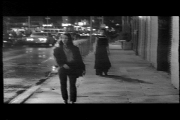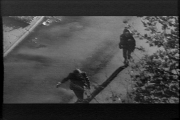Uploaded 30 June 2000
The true hero, the true subject, the center of the Iliad is force. Force employed by man, force that enslaves man, force before which man’s flesh shrinks away. In this work, at all times, the human spirit is shown as modified by its relations with force, as swept away, blinded, by the very force it imagined it could handle, as deformed by the weight of the force it submits to….
To define force-it is that x that turns anybody who is subjected to it into a thing….It makes a corpse out of him. Somebody was here, and the next minute there is nobody here at all…From [force’s] first property (the ability to turn a human being into a thing by the simple method of killing him) flows another…, the ability to turn a human being into a thing while he is still alive. He is alive; he has a soul; and yet-he is a thing….And as for the soul, what an extraordinary house it finds itself in! Who can say what it costs it, moment by moment, to accommodate itself to this residence, how much writhing and bending, folding and pleating are required of it? It was not made to live inside a thing; if it does so, under pressure of necessity, there is not a single element of its nature to which violence is not done….
Perhaps all men, by the very act of being born, are destined to suffer violence; yet this is a truth to which circumstance shuts men’s eyes….They have in common a refusal to believe that they both belong to the same species: the weak see no relation between themselves and the strong, and vice versa…. [The strong], wielding power, have no suspicion of the fact that the consequences of their deeds will at length come home to them….[But eventually it does, and] nothing, no shield, stands between them and tears.
This retribution, which has a geometrical rigor, which operates automatically to penalize the abuse of force, was the main subject of Greek thought. It is the soul of the epic….To the Pythagoreans, to Socrates and Plato, it was the jumping-off point of speculation upon the nature of man and the universe. … In Oriental countries which are steeped in Buddhism, it is perhaps this Greek idea that has lived on under the name of Karma….The Occident, however, has lost it, and no longer even has a word to express it in any of its languages: conceptions of limit, measure, equilibrium, which ought to determine the conduct of life are, in the West, restricted to a servile function in the vocabulary of technicians. We are only geometricians of matter; the Greeks were, first of all, geometricians in their apprenticeship to virtue….
Thus violence obliterates anybody who feels its touch. It comes to seem just as external to its employer as to its victim. And from this springs the idea of a destiny before which executioner and victim stand equally innocent…, brothers in the same distress….
[The Iliad’s] bitterness is the only justifiable bitterness, for it springs from the subjections of the human spirit to force, that is, in the last analysis, to matter. This subjection is the common lot… No one in the Iliad is spared by it, as no one on earth is. …The sense of human misery is a pre-condition of justice and love….Only he who has measured the dominion of force, and knows how not to respect it, is capable of love and justice.
Those who think that God himself, once he became human, could not hold the severity of his fate before his eyes without trembling with anguish, should understand that the only people who can appear to rise above human misery are those who mask fate’s severity from their own eyes with the help of illusion, drunkenness or fanaticism. No one who is not protected by the armor of a lie can suffer force without being struck to the soul by it. Grace can prevent this blow from corrupting us, but it cannot prevent the wound.
-Simone Weil. “The Iliad or The Poem of Force.” Written in 1939, in response to the coming war. Signed with an anagram, Émile Novis, because a Jew could not have been published .[1]
Ms. 45, in the 1981 movie of the same name, is an innocuous young woman, until she is raped twice. Then she gets a forty-five and goes looking for men to execute. As in Death Wish(USA 1974). Except that the point there is that Charles Bronson is unaffected by his murders, whereas here Ms. 45 changes costume with each excursion, progressing from nice convent girl, to sophisticated model, to high-class hooker, to dominatrix, and does so not to bait her prey, but to luxuriate erotically in her own sadism, in the foreplay of attraction. We can avoid paying a toll to force and morality with Bronson, but not with Abel Ferrara. Pleasure, in the world of his films, usually becomes pain, sex becomes violence, virtue vice; the victor is destroyed as surely as the victim. Ms. 45’s climactic identity is as a nun, by which she intends to represent not her own sexual repression, but rather desire and death, the violence of the feminine that attracts only to deny, the vice in virtue. Yet she herself has reached a point where pleasure can be achieved only in intense pain, where neither satisfaction nor even release is anymore attainable. Most Ferrara heroes will reach a similar point, insatiably addicted to force.
Life is hell in Ferrara, torture without escape, without a moment’s release. His movies doubtless owe much, conceptually, to Nicholas St. John, friend and scenarist of most of them. But they are less about concepts than feelings- how it feels to live without grace, to be victim of force. Alienation is portrayed so intensely, in colors, shapes, surfaces, lights and bodies, that one thinks of the Murnau of Sunrise (USA 1927), alive today and making exploitation flicks. Ferrara’s movies are bad trips, very bad trips, uncompromisingly moral.
Says Ferrara:
It’s more feelings and emotions and how colors and textures bring about certain feelings. It’s not the theme – I don’t think about the theme of the movie. The goal is not the film; the goal is to be whole, to be involved as a human being – knowledge, self-knowledge, group knowledge, whatever.[2]
Fear City (USA 1984) is about strip tease and Ferrara’s women (and men) are even more erotic than Hawks’s. They love making every little movement into erotic turn-on. But Ferrara’s women don’t behave like pros, they’re really having a good time. In the way Melanie Griffith, wearing only a thong, takes evident pleasure contorting her body for a paying male audience, there is no hint of “tease,” no hint of the “sin” with which Sirk stages a milder scene in Imitation of Life(USA 1959), only a kind of contentment that might have existed in an appleless Eden.
But, intercut with Melanie Griffith and outside of Eden, the men react like raging depraved ghouls, with no dignity, while one man with a knife, in an alley outside, with almost unwatchable violence, slashes and mutilates an off-work stripper.
The slashing is as much a reaction to the second set of intercut material (the ghoulish men) as to the first (erotic Melanie). The slasher is a youth who passes his days doing (erotic) martial-arts drills nude, with extraordinary dignity. He is totally pitiless to the pain he inflicts with his knife, a characteristic of all Ferrara’s “vampires.” We understand he intends his life to be a demonstration of his ability to retain male dignity (male eroticism) by defying women and tenderness and the debasing emotions they inspire. But like Ms. 45, he has made himself a slave of his own eroticism, has consumed his life in his sex drive, has sold his soul to force, so that each of his victories makes him more force’s victim.
Are the women responsible for the men’s reaction? Are the men simply snakes? Ferrara seems be saying, like Murnau in Tabu (USA 1931), that no one is free from what Simone Weil calls the “gravity” of human society, in which beauty becomes pain, love becomes violence, dignity becomes brutality.[3] It’s feelings that are Ferrara’s themes: here the polyphony of three contrasting reactions to erotic play.
Accordingly, Ferrara’s best moments are his most stylized. One has the impression of ideas excitedly worked out by someone whose supreme joy is doing cinema. In China Girl(USA 1987), his favorite production, he extends almost to an entire movie the high pitch of stylization found in one of the best scenes in Ms. 45, in which four molesters rotate demonically around their prey with ritualistic brio, their shadows preceding them. As in Murnau’s movies, cinematography in the abstract has something of the richness of music in the abstract. Thus geometric surfaces, textures, colors, light and darkness tend to mythify any situation, as with Murnau, Eisenstein or Ford. Ferrara’s shots are composed with conscious geometry, inventively balanced in internal lines, planes and angles, always to expressive effect, always with delight at photographic effects of limited depth, sfumato, foregrounded objects, patches of brilliant light, shadows passing. A shot down a street may have a fire hydrant as a kind of proscenium arch; as in Sirk or Ford, objects impose the world we relate to and the characters struggle against. Objects can make us objects ourselves, things. All patterns are inimical in China Girl; society is structured as rigidly as the grids of the streets in Little Italy and Chinatown. Thus every generic situation is stylized: the guys strut, knives spin, the gangs take over the streets like corps de ballet. Everyone wears black at the dance, except the two rebels, the iconoclasts, Tony and Tyen, the Romeo-and-Juliet teenagers in white tops, spotlit – just the way Jean Renoir first draws our attention to Nini in French Cancan (France 1954) – not just to make us notice these characters, but to empathize with them, to enter the movie’s storyworld with them, where, indeed, we will find these empathetic youths (and ourselves, to some extent: a movie character being a locus of emotions) constantly threatened by geometric structures, by the force of another character’s gaze upon them, by the force of the camera tracking in upon them, by the force of our own gaze, which is akin to sharing their own self-consciousness of their situation.
The dance aside, Tyen asserts her own viewpoint not at all, and Tony only at Alby’s funeral, when he denounces the mafia don for selling his soul to force. The geometric clash that results tells us that Tony’s violent moment of truth only ties him more tightly to the structures of destruction. Such is force. The camera makes us experience force physically. It becomes force, when Ferrara pans from the assassin into an accelerating tracking shot onto Tyen and Tony, miming the bullet. In contrast, after all three are dead, the camera recovers the distance with dread, focused on the street, until it reaches Tony and Tyen, and spirals up, up into the sky, no longer the point of view of character but now an imagined narrator, whom I imagine to be saying, “For never was a story of more woe / Than this of Juliet and her Romeo.”
Yeah, the texture. It’s not always ‘What happens next?’…but what is there? What is the story? What is Frank White – we know as much about him from the guy’s clothes or the people around him. The physical objects – the thing that you can do in film is take physical objects and study them. You’re filming objects – what else can you do? People as objects[4]
There is a rich specificness. In China Girl, Tony comes into his room, peels off his shirt, throws himself on his bed and watches an erotic video; the high angle on the boy recalls the strange high angles of the dinner table in the first reel of Sunrise (USA 1927), giving a sense of theater and the sacred in both movies: thus the small brown cross on this Italian boy’s white wall is as powerful as the eroticism of the actress in the video.
She too loves to turn guys on and snatch their bodies, and maybe their souls. Ferrara has a vividness in portraying people whom we see for only a few seconds; as with Ford (Ferrara is half Irish), even brief reaction shots are cameos of characterization, with beginnings, middles, and ends. The drama is defined, during the title sequence, in a series of vignettes of seven Italians watching an Italian bakery being changed into a Chinese restaurant, climaxing with Alby smacking his fist and a fade out.
Lighting bestows a moral attitude. Characters become their shadows passing on walls, or parts of themselves, or ghosts, as force snatches them. Shadows stalk before them, when they want to think of themselves as erotic heroes strutting through ancient rituals of violence and courtship, which is almost all the time for Ferrara’s men, and his women too, only in a different register, as again force snatches them and authenticity dissolves in posturing.
The shadows that stalk before turn people into figures, pieces of themselves, vampires. One person in blind flight for life, another in blind pursuit for erotic glory. They streak through pools of black nothingness or drenching illumination, alternately gaining and losing, with no other purpose. Light and dark do not indicate good and evil (and comic relief is ghoulish); for Ferrara is not Manichaean, he’s in hell’s seventh circle. So light embarrasses and shadow hides. Everyone bristles with sperm and scent. But lust is so rarely fulfilled, even among those “protected by the armor…of illusion, drunkenness or fanaticism” (Weil), that desire normally is pain, torture and madness. Most Ferrara heroes get posed masturbating and, in contrast to the haloed saintliness of Melanie Griffith’s pleasuring, or the impassioned ruttings of China Girl‘s lovers, they masturbate sadistically or masochistically – re-enacting on this field too the victories and defeats on the plains of Troy.
Ferrara’s moral probing contrasts with a profoundly immoralfilm like Basic InstinctUSA 1992), where sadomasochism is celebrated with more glee than girlwatching in Renoir. Simplistic materialism lurks in Basic Instinct’s title, whereas nihilism in Ferrara’s movies is the destiny of souls who have become things while turning away from God.
In the second half of King of New York (USA 1990) Ferrara acknowledges Murnau with a clip from Nosferatu (Germany 1921) and by having his hero (a vice/virtue, Ms. 45/nun, vampire/angel type named “White”) walk around in a long black coat identical to the coat Murnau’s vampire wears. But Murnau is already evident in the movie’s first shot: the prison bars, the shadowed form that turns and emerges into half-light crazed, doomed, already dead and preying. Outside, a plane rises above the skyline like a winged phallus. Cubistic Manhattan looms as a challenge, a mission, a fate; its lights give energy, sexuality, that lure the white vampire of the dark. White materializes in daytime only once, for a funeral, in a black limousine like Nosferatu’s casket, with opaque windows that open for his black shotgun to ejaculate death. Surnaturally, he snaps into orgasmic violence and bisexual allure, whether to bewitch his rutting female “Park Avenue attorney” with promises of a necrophiliac fuck (“I want to take you on the subway”), or by breaking into dance to claim the loyalty of his black minions who, like Tabu‘s Polynesians, jive with dancing bodies, musically, balletically, theatrically. No one stops rutting and strutting, even standing still.
Yet even so, in striving to sin, to blaspheme, Ferrara’s heroes assert with Lucifer their moral autonomy, their sovereignty, their heroic identity, their glory, pitifully. “The entire world’s a graveyard and we the birds of prey,” Christopher Walken’s vampire proclaims. “Mankind has striven to exist beyond god and evil from the beginning.”
This is the drama in Bad Lieutenant (USA 1992). The question is: given our constantly powerless in the face of the outer world, and our own depravity, what possibility remains for meaning? or for goodness?
In response, Basic Instinct invites us to enjoy ourselves inflicting pain. But Ferrara’s bad lieutenant reminds us of the bad thief crucified next to Jesus, who acknowledged he deserved hell, and so gained paradise – like Kathleen, or like the nun in Bad Lieutenant who has been raped and tortured and blames herself (the victim) rather than her attackers: “Jesus turned water into wine. I ought to have turned bitter semen into fertile sperm, hatred to love, and maybe to have saved their souls. They did not love me but I ought to have loved them.” Is this not a different conception of Christian purity than that of Pius XII, who canonized a teenager for leaping to her death rather than submitting to a lecher? Bad Lieutenant‘s characters are too weary to indulge in such heroics, or in the ritualistic bravura of earlier Ferrara films. Here everything is internalized. One thinks less of hedonist Murnau and a cinema of “presence”; more of Jansenist Bresson and a cinema of absence: the harsh implacable lighting; the iconic poses; the mystery of faces; the way certain objects are distinguished; the extreme disagreeableness of existence; a style of cutting that relentlessly insists on forcing equations through moral geometry – for example, the cuts cited in Fear City or, here, the cut from a harshly illuminated claustrophobic pose against a white wall, with subway sounds in background, of Zoe Lund floating into a hashish high, to a statue of Mary being toppled and the nun being raped in the background (and looking like Edvard Munch’s scream of agony): an equation that insists on the common lot of fallen humanity, on the shared sin that prompts the nun to see her rapers as her victims, and that prompts Ferrara to repeat the subway sound when the rapers are arrested. “Vampires are lucky, they can feed on others,” declares Zoe Lund (who also scripted Bad Lieutenant, played Ms. 45, and was maybe alluding to King of New York). “Vampires are lucky, they can feed on others. We got to eat away at ourselves. We got to eat our legs, [so] we get the energy to walk. We gotta come so we can go, we gotta suck ourselves off, we gotta eat away at ourselves so there’s nothing left but appetite. We give and give and give crazy, and the gift that makes sense ain’t worth it. But you better do it. Jesus said ‘seventy times seven’ [i.e., the number of times to forgive your neighbor]. You know no one will understand why you did it. They’ll just forget about you tomorrow.”
There is nothing Bressonian about Harvey Keitel’s acting. His disintegration recalls Victor McLaglen’s in The Informer (USA 1935). Yet it’s the same hysteria that one senses in Bresson, behind the almost-blank face of Claude Laydu, the alcoholic curé in Diary of a Country Priest (France 1950); all three characters eventually recognize life as a via crucis sharing in the divine agony. Bad lieutenant craving forgiveness cannot look at an attractive woman without raping her with his gaze. He’s a vampire in a film full of vampires.
And he is no freer in graphic terms. When not trapped in close ups of moral solitude, vampire-people are crushed in deep compositions of moral determinism, and constrained by geometric equations of the montage.
At the far rear of one exemplary design, the lieutenant wakes from a miserable nap on the livingroom couch; kids ramble around; in foreground the dinnertable with fruitbowl fills half the frame; the furnishings are tasteless and synthetic; on the blaring tv a cartoon from World War II mobilizes the mice to “get rid of the cat” while a chorus of armament workers sing gaily, “We did it before and we can do it again!”; and the lieutenant switches the channel to learn he has lost $15,000 betting on baseball – a loss he will stubbornly compound into a $120,000 debt that will cost him his life. The scene follows directly after the one of Zoe Lund’s hashish, with the rape of the nun in between; like Humphrey Jennings, Ferrara surrealistically juxtaposes discordant material, and reveals we are bound to even the unlikeliest of our neighbors by a social fabric that is tougher than our differences.
Yet while Jennings (like the mice) sees cause for optimism in solidarity, Ferrara sees a massive quicksand pulling all to hell. The series of madonnas who point the lieutenant toward heaven are as drugged and traumatized as he, as crazy as prophets have always been. Perhaps for this reason Bad Lieutenant‘s last two shots recall the last shots of Antonioni’s The Passenger (Italy/France/USA 1975). Both heroes die, having achieved a self transcendence whose measure is so qualified, so uncertain, so problematic and contradictory, that we are overwhelmed by the pathos of the ambient noises, the silence between faith and despair.
Cinema of Ferrara’s kind requires that we sense with extraordinary vividness the “presence” of a character: the way a character’s “vibes” take possession of the frame’s empty spaces – as in Tabu, where air and light become the character’s emanations, like in Vermeer’s paintings, like in Tony’s bedroom, and unlike in Tyen’s bedroom, because here she feels she is not there. Opaqueness, as in Tabu, is part of the vividness; the more we feel characters’ emotions, the more we understand them, the more we are aware of impenetrable innerness, and that Ferrara, like Murnau and Ford and unlike Basic Instinct, sees us as life’s actors, not its victims. Texture and color, geometrics and composition are so intense, that it seems a miracle anyone could support such an existence for ten minutes; yet Ferrara’s characters transcend their environment even as they succumb to it (witness the haunting dolly in on China Girl sitting rootless on her bed): they are never just mannequins. They may be slaves to their passion, but they choose their passion. They don’t just give in, they choose to give in. Ferrara believes more in sin than in Freud. If we have no responsibility, no guilt, then we are puppets in a Punch & Judy show, our pain is a farce, and only force is real, pulling the strings. So conclude the heroes of Ms. 45 and King of New York, who try to kill everyone evil, thinking they can master force, like Christopher Walken’s vampires in The Addiction (USA 1995)and New Rose Hotel (USA 1998). Ferrara’s not jerking off, like Basic Instinct; he’s insisting that life is genuinely tragic. His heroes degrade themselves in Bad Lieutenant (1992) and Driller Killer(1979), The Addiction and New Rose Hotel, humiliating their victims or torturing them to death with a powerdrill (merely to masturbate), or eating them alive, or killing them en masse. An exploitation film, by definition, invites us to enjoy blood, gore and cruelty. But Ferrara wants our disgust to overwhelm our fascination, so that, as The Addiction proposes, we experience “metanoia” – a kind of catharsis by which we shall reject our vicarious complicity in evil.
Metanoia is Greek word meaning a change of mind (noia) and, more specifically, a religious conversion through the enlightenment of death and rebirth. The greatest obstacle to such change of mind is the knowledge we think we already know. As Simone Weil says, our thoughts block God’s grace, which can enter only where there is a void. And Kathleen Conklin in The Addiction makes a similar point when she remarks “We drink to escape the fact we’re alcoholics” without realising (yet) that her philosophy is her alcoholism. What she thinks she knows, argued in her doctoral dissertation and based on her life as a vampire, is that we cannot turn toward the light because we have no free will. We are vampires. Massacres like My Lai happen repeatedly, because we cannot tell evil to go away, cannot control our deeds. “You’re nothing….you’re not a person. You’re nothing.” We are what we do, she insists, slaves of force. Such is the universal condition of humankind.
“Look what you’ve done to me,” cries one of her victims. “How could you do this? Doesn’t this affect you at all?”
“No. It was your decision,” Kathleen retorts. “Why didn’t you just tell me to go?…My indifference is not the concern here. It’s your astonishment that needs study.”
“What echo,” explains Simone Weil (of the Iliad, but it’s the same case), “can the timid aspiration for life find in such hearts, when the victim begs to see another day?” Force turns us into things. “It’s the violence of my will against theirs,” explains Kathleen. There is no unconsenting victim and no distinction between victor and victim: the victims become vampires too. Force begets force; there is only force.
Ferrara configures the geometry of force as he did in China Girl. Lines of motion are force. Three successive vampire attacks are filmed with similar background-to-foreground lines of motion:



The attacks climax in Kathleen’s My Lai, her PhD reception, a vampiric orgy accurately dramatizing the life of academics on the prowl. She gorges herself nearly to nothingness. “In struggling against anguish,” said Simone Weil,
One never produces serenity; the struggle against anguish only produces new forms of anguish… There must be a tearing out, something desperate has to take place, the void must be created: the dark night…Only those people who have fallen to the lowest degree of humiliation, far below beggary, who are not just without any social consideration but are regarded by all as being deprived of that foremost human dignity, reason itself–only those people, in fact, are capable of telling the truth. All the others lie. [5]
“We should all hope to feel guilty, to feel pain,” Kathleen’s professor had lectured months earlier concerning metanoia, “so we can seek pardon and ultimately freedom. Guilt is a sign that God is working out your destiny and it’s a foolish person who refuses to acknowledge this.”
“Nobody’s gonna let you die,” promises a nurse now, and Kathleen asks for light, which kills vampires, which is what she wants, but it does something else besides, as it descends slowly over her from the crucifix above her bed. “We stand before the light,” she comments afterward, “and our true nature is revealed.” The false self will be buried, the true self reborn.
Ironically it is the first vampire, the one who infected Kathleen, who shows up again now, ostensibly to deny responsibility (“What choices do such people [like us] have? It’s not like we have any options!”) but inadvertently to affirm it. “We’re not evil because of the evil we do,” the vampire mocks, refuting Kathleen’s dissertation, “but we do evil because we are evil.”
So there is a person; we’re not just the product of our deeds. It’s the soul that counts ultimately, not the deeds. We can be forgiven, the past can be put behind, spring can come.
Accordingly, cut to the next shot, where the geometry of force is annulled:
As the vampire retreats steadily in the frame, a priest ambles forward, a common-man priest like John XXIII, whose casual waddle and receptive demeanor belies the aggressive strides of the vampires. All walk with obsessive missions, but the vampires are driven, whereas the priest is making his own choices. He even nods hello to the passing vampire. Here in the humblest form is power not bound to force. Ferrara gives us forty-two seconds to meditate on this transit, and it may be the richest moment in his work, a moment of metanoia. The old life fades into the distance, the new one succeeds, as simply as two contrasting vectors in moral geometry. And just as simply as that, the world is redeemed. Nicholas St. John, said Ferrara, wrote this movie “soon after the death of his first son. At the saddest time of his life, he found a way to express that relentless search for truth and light in a world that often paralyzes us with its anger and darkness.”[6]
After King of New York, the thrills and gore we once expected from a maker of exploitation films recede into suggestive symbol, or move offstage entirely. New Rose Hotel has so little “action” of any sort, that the true plot becomes something to discover in repeated viewings. We never see the scenes we’re waiting for, Sandii seducing Hiroshi, his snatch, his death. Ferrara deleted them. What we get are only the human moments between events, what’s happening in people’s minds, and here too the key moments may be missed, as they pass in an instant over someone’s face, and only later are dimly understood. This is not a movie likely to satisfy anyone on first viewing. As often in Ferrara, there may seem to be far less going on than there is, because he trims expository scenes and explanations, and dialogue is often tongue-tied anyhow, and because we, while searching for what is not there, may miss what is. (We have to create a void so grace can enter in.)
We’re still on the plains of Troy, but the war is now just a stage set; there are only three heroes; and their geometry of force is internalized. New Rose Hotel is a character study, but the apparent storyline is so much a red herring that we may not recognize which character is most studied.
Synopsis: In the near future, mega-corporations rule the world, which is engulfed in pollution. A brilliant Japanese biologist, Hiroshi, works for Maas and rejects offers from Hosaka. Hosaka agrees to pay two corporate raiders, Fox (Christophen Walken) and his deputy, X (Willem Dafoe), $100,000,000 to deliver Hiroshi. So they hire a prostitute, Sandii (Asia Argento), to bait Hiroshi with “the one thing he lacks: passion.” X sets out to teach Sandii how to “fall in love without falling in love” in order that she can snare Hiroshi, but falls in love with her himself, and she, apparently, with him. Sandii seduces Hiroshi, the snatch works, then backfires, when Maas unleashes a germ that kills all Hosaka’s biologists. Sandii disappears; Fox says she sold out to Maas. Hosaka blames Fox and X. Fox kills himself, and agents are closing in on X, who spends the film’s last twenty minutes hiding in an airport cubicle, the New Rose Hotel, flashing back to earlier scenes, masturbating masochistically, and trying to figure out if, why, or when Sandii sold them out to Maas.
Even as X recognizes Sandii’s deceptions, he cannot stop desiring her. This is explicit in William Gibson’s original story. And this is apparently the point that so attracted Ferrara when he read that story. (“I knew we were fucked. Cause it was great and I knew I had to do it.”) In Gibson and Christ Zois’s script, as Hosaka’s helicopter approaches, X fantasizes: “I just can’t hate you, baby. It’s all right, baby. Only please come here. Hold my hand.”[7]
But what is explicit in Gibson and Zois exudes a painful ambivalence in Ferrara. In Ferrara’s version, X recalls seeing in Sandii’s passport the computer card that later unleashed the germ. But is it certain that Sandii wittingly sold them out? And isn’t it X’s fault, because didn’t she say, that same night, that they should forget about Hiroshi, that they should run away and marry and have children, and didn’t he send her back to Hiroshi instead? To her death?
Thus the movie ends with X repeating twice, first in his head, then in a flashback to Sandii, as he gets into bed beside her, “If you really want, we’ll walk away [ie, forget about Hiroshi].” And she smiles
Did this happen actually? or is it X’s fantasy of what he should have said?
And, whichever, would it truly have made a difference? Is Sandii smiling in reaction to X’s words because they’re getting married? or because he’s fallen for her game? Is her smile sweet? or vile?
The camera suggests the scene did happen, because Sandii’s smile happens out of X’s view. And the more we meditate on the evidence, including that smile, the more we realise that X has not yet accepted the full horror of what he has realised, the extent of Sandii’s deceptions. At the time she proposes marriage, she already has the computer card, she already has consented to X’s murder; indeed, she already has agreed to commit mass murder herself. She began to lie even before meeting Hiroshi. (First her father was Italian and worked for Hosaka. After Hiroshi, her father is French.) She passes for a low-class whore, concealing a second identity as a doctoral student (like Kathleen) – another danger signal X finds in her purse and ignores. She asks X to marry her to tease him, to torture him, because he resents her “sucking Hiroshi’s cock” – after training her to do it. She is not angry, and then immediately maternal, for the reason X wants to think, however. She will kiss him goodbye a few hours later, him half asleep and her off to suck Hiroshi’s cock (off). Not for nothing did Ferrara begin this bed scene with a loud roll of thunder.
Sandii seeks sex indiscriminantly, insatiably. In Gibson and Zois, she wipes out Hosaka because Hosaka killed her father; in Ferrara, she has no discernible motivation, ever, except self-pleasuring. Fox was correct. “She’s a punch board,” he had said. “Teach her to fall in love without falling in love yourself,” he had said. “Just watch me,” X had replied, as he charged off to rub her up with Fox watching. Sandii’s idea of a good evening out, during her “love affair” with X, is to drag him into a sex club where she ignores him and plunges into the orgy, while he watches masochistically in black silhouette, convincing himself he’s a cavalier and she’s his toy.
Of course he is hers. He thinks he is “teaching” her, when he has her coo “Hiroshi!” while he fucks her. But she is “practising” on him. “I’d cry, and I’d die, and I’d fly for you” (with tongue flicks into his mouth). For X, “Hiroshi” becomes the third person essential to romantic love, which thrives on rejection, on triangular geometries of force, and Sandii uses X’s jealousy to manipulate him. For her there are no rejections, so she can fall in love without falling in love. Not X. “You’ve got to have your head clear to pull this off,” Fox had warned him. But X hadn’t had his head clear, and now everyone’s dead, and he will be too.
Fox and X constantly misidentifty Sandii, and this is the reason she kills them. It’s the game. They think she’s way beneath them, an object for purchase; they are fools. They miss the macho way she lights her cigarette, leaving it in her mouth, like a cock, as soon as she realises there’s a game to play. Fox has too much hubris: he brags his profession is “not about money. It’s about action! It’s not about doing something and calling it a day” and he fails to notice that Sandii feels the same and has no need to brag. “She’s a real whore,” someone tells him. Not a fake one! It’s a game for everyone, drug lords and governments. The playing fields of Troy. Force reigns everywhere; there are no more good intentions such as the king of New York or bad lieutenant had. We’re all vampires now, body-snatched. The movie begins with everyone in red light or black shadow: this is hell. Red light, like Homer’s rain, falls on all alike: appetite, lust, power. “It does not behoove a gentleman to be introspective,” Fox declares. “We are the wolves. Steppes. Isolated. Singular full façade, the perfect wolf you are – eyes glazed, lips parched, ribs showing. Hungry!”[8] And he looks it: a wolf, a vampire, glazed, mean, nasty, totally selfish, ruthless. He even snarls. It’s a shock when he smiles. Is his happiness different from mine? Does pleasure have morality?
Fox is ugly, off-putting. Sandii is beautiful, warm, engaging, a more interesting (and dangerous) vampire than any of Ferrara’s other vampires, a more interesting (and realistic) treatment of evil than any of Ferrara’s other moral essays, because she is enticing. She revels in caresses, in animalistic sex, and makes us want to join her pleasure – which will be to destroy us. The male wolves forget the game; she’s just a girl, a toy. Fox even points at her like a new car: “This was my masterstroke! Look at that! Here we go!”
It is by dint of X’s and Fox’s and Hiroshi’s apparent victories over her that Sandii makes them her pawns. Such is the geometry of force. Like Hallie in Ford’s geometric Man who Shot Liberty Valance (USA 1962), Sandii destroys three men in the course of getting what she wants. She’s a better wolf than Fox or X, because she enjoys being a wolf. She has fun being a whore. She adores being a dominatrix. X thinks he is “teaching” her to fall in love without falling in love, her, the master of role playing, the carnival that never shuts down. Her appearances are a series of costume roles, like Marlene Dietrich’s in Sternberg’s Blonde Venus (USA 1932): singer, whore, sweet girl next door, porno queen, chicken, nympho, innocent virgin, exhibitionist, scientist, mother, coquette. She always battles to the top: dunking X in the pool, climbing the ladder, fucking in bed, playing the Great Game. In retrospect everything is clear: it was all decided in the first minutes, when Fox called her a dumbbell. “In case you didn’t notice,” he snarled, “you’re dead, you just don’t have the sense to lay down [as a wolf would].”
It happens during an instant, as she lifts her eyes up and looks at him. Vengeance is sworn.
We may miss this. But not her resentment. Ferrara films emotions, not explanations for what people eventually do. His screenwriter, Christ Zois, cites an example of this (in his DVD commentary), complaining Ferrara cut a scene outside the sex club showing that Sandii drags X in against his will. In fact the scene is still clear, but only if we attend to the body language. And it is still clear what this scene says about the nature of their “love” affair, but only if we think about the emotions; else like Fox we shall prefer to believe at the end in our own self-deceit. We shall hear her voice in X’s dreams – “Many months ago I was so beautiful and lovely when you first saw me…and I was wearing black.” We shall sense the egotism, the dominatrix; but we shall not comprehend.
We shall watch her, a gamine in bed, saying, “Yeah! Yeah! When I come back!” (after X says they will discuss marriage when she comes back from Hiroshi), and we shall prefer to hear happy acceptance rather than sadistic sarcasm. (Kathleen, in The Addiction, uses the same tone when she reassures an intended victim, “Sure, I’ll come over.”) And we shall see Sandii’s vile smile at movie’s end (unequivocally vile in Zois’s script), and shall prefer to think she is sweet. “Imagination,” said Simone Weil, “is always the fabric of social life and the motor of history. The influence of real needs and compulsions, of real materials and interests, is indirect because the crowd is never conscious of it.”[9]
X relishes Sandii’s movements and ways and voice, even as he notes their lethal calculation. Opaqueness is her torture: it lets us go on deceiving ourselves. Is she ever not playing a game? Is there any authenticity in her? In anyone? X clings to doubt to cling to Sandii, to cling to love, to cling to humanity, loyalty, principle, friendship, in a world of skyscapes everywhere dirty-grey, rot with pollution, from which no deus ex machina comes to the rescue this time, and the bloodiest vampire reigns: Sandii. X’s masochism is the best hope Ferrara can find to redeem the world.
Which accords a certain glory to Sandii, a glory in victory, in sadistic fulfillment, like in the Iliad when Achilles cuts the throats of twelve Trojan boys on the funeral pyre of Patroclus, or the joys of killing “Japs” in Howard Hawks. This female is clearly the evolutionary choice to dominate in this world, whereas the male is a ridiculous figure whose undoing is his own introversion (as in Raoul Walsh). Like Fox, Sandii rejects introspection. Just win. There is heroism here. Red Rose Hotel insists we admire Sandii, just as The Addiction insists we admire vampirism, My Lai, Hiroshima and Auschwitz. “Now I understand how it was all possible!” Kathleen exclaims.
Indeed, I once met Arabella from Milan, one of Ferrara’s biggest fans, who admires his vampires to the point of emulation. Like Sandii, Arabella would decorate herself to stroll down the street and hear people say “Charming!” (as they always did). She worshipped John Woo too, and couldn’t understand my objections to Woo’s climaxes, where the hero stands over the helpless villain and, after considerable meditation, shoots him in the head like a thing. It’s exciting, reducing people to figures and blowing their brains out. Arabella loved games. “I’m just a poor little girl,” she’ exclaim; but like Sandii, like Kathleen, she played every moment to win and didn’t have time for victims, except as pawns. “It’s not deontological,” she’d explain, twirling a tress and citing Hegel. The Addiction was a masterpiece, she said, but I could not get her to tell me what is going on in its last scenes; the vampires were her “gods.” For Arabella, what was intoxicating was having “edge,” as Fox calls force. So there is more than one way to enjoy Ferrara.
But, as with Homer’s denatured heroes, with all that “heroism” what place is there for anything else? “It does not behoove a gentleman to be introspective,” brags Fox, whose leap to his death is admittedly magnificent – in contrast to X, cringing in a womb. Yet “it is not possible to love and be just,” Simone Weil writes, “except by knowing the empire of force and how not to respect it.” Force is as pitiless to the person who possesses it, or thinks she does, as it is to its victims; the second it crushes, the first it intoxicates. The truth is, nobody really possesses it.
Sandii vanishes, walks out of the frame; no one knows her family name or where she’s from. Sandii’s speech to X is about herself: “Nobody will ever know your name. Nobody will ever cry over you. Is this how you want to die?” She has no existence beyond her deeds, her force, her deceptions.
(“Who is this ‘Lenore’?” Ferrara interpolates, in his CD recording of Poe’s “The raven.”)[1]
Footnotes:
[1] Cahiers du sud, XIX, 230, December 1940. English translation by Mary McCarthy (except for final paragraph), Politics, November 1945.
[2] “Moon in the Gutter: Abel Ferrara interviewed by Gavin Smith,” Film Comment 24, no. 4 (July-August 1990): 44.
[3] There is a “good” love story in Fear City, in which Melanie and her co-workers are saved by her talent agent, who, however, must first recover his will to fight (like John Wayne in The Quiet Man). “You think you’re a hero? Well, maybe you are,” a policeman tell him at the end. But, with the exception of Kathleen Conklin’s resurrection in The Addiction, anything like a happy ending seems, in a Ferrara film, implausible, impossible, and inconsistent. The moviemaker’s lack of commitment is evident in the relative lack of stylization with which many such subplot scenes are staged, here and in other films in which decisions were imposed by producers.
[4] Smith, Film Comment: 44.
[5] Draft of letter to Andre Weil 1940 in Richard Rees, ed., Seventy Letters(London: Oxford University Press, 1965). “Accepter la vide,” La pesanteur et la grace (Paris: Agora pocket, 1991) 19. Letter to her parents, 4 August 1943.
[6] Gavin Smith, “Interview with Abel Ferrara and Nicholas St. John.” This quotation is from a promotional website which is no longer posted.
[7] A.G. Basoli, “Abel Ferrara jams with ‘New Rose Hotel’.”http://www.indiewire.com/film/interviews/int_Ferrara_Abel_981019.html
Gibson, “New Rose Hotel,” in his collection Burning Chrome (New York: Ace paperback, 1987) 116. Zois’s script is included on the DVD, but is accessible only to PCs with Windows and a DVD player.
[8] Much of Christopher Walken’s dialogue is improvised and Ferrara has retained its occasional incoherence; e.g., “For every drop of rain that falls, a cloud will grow.”
[9] “Méditations sur un cadavre 1937” Oeuvres completes, tome II, v. 3(Paris: Gallimard, 1998) 74-75.
[10] At Halloween concert at St. Ann’s Church, Brooklyn (1996), excerpted on the CD, Closed on Account of Rabies: Poems and Tales of Edgar Allan Poe, produced Hal Willner. Paris Records/Mouth Almighty Records/Mercury Records 314-536-480-2.








